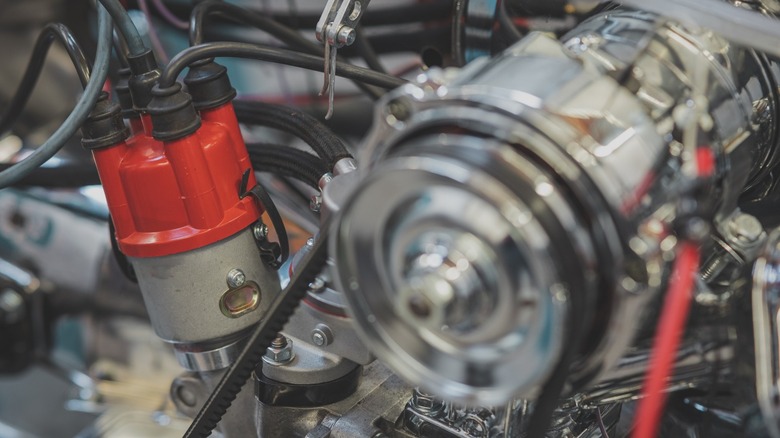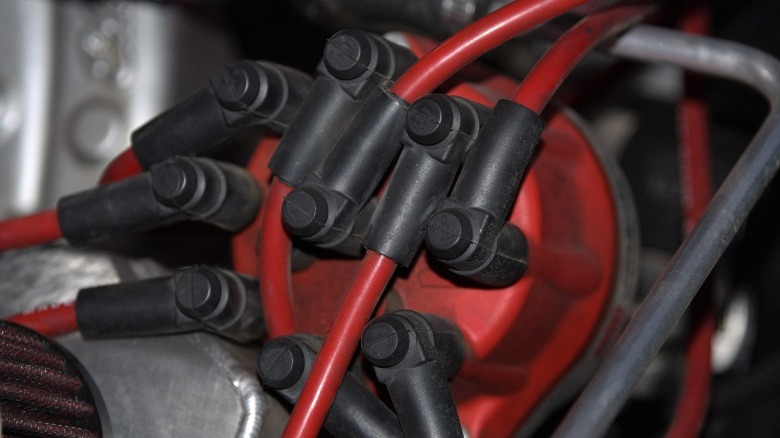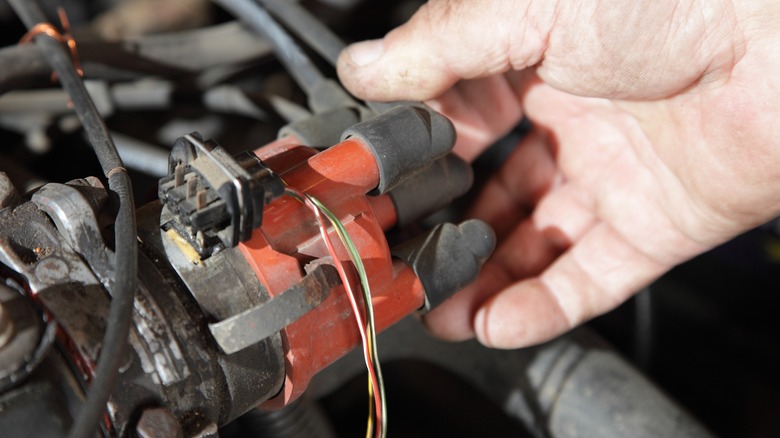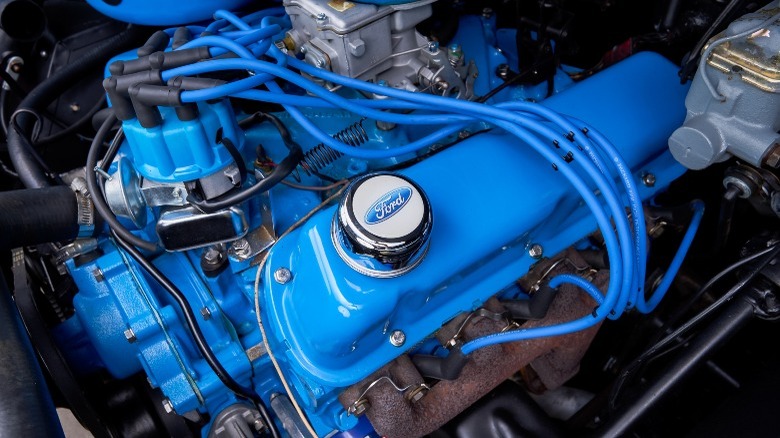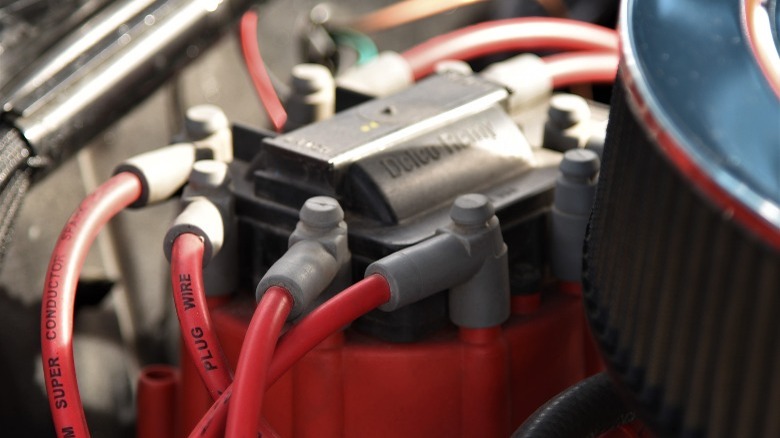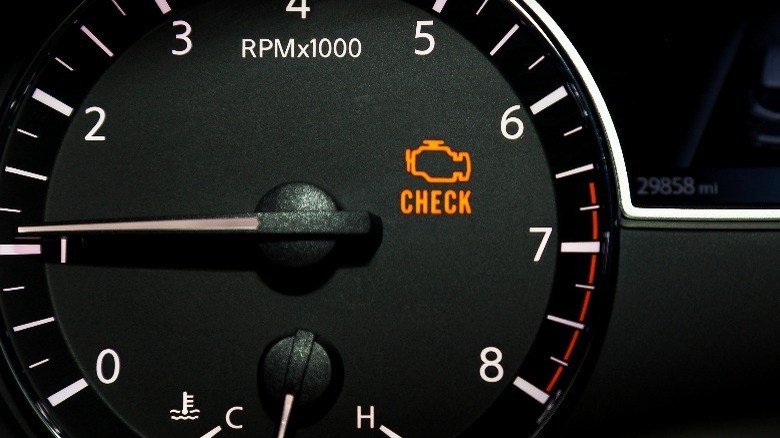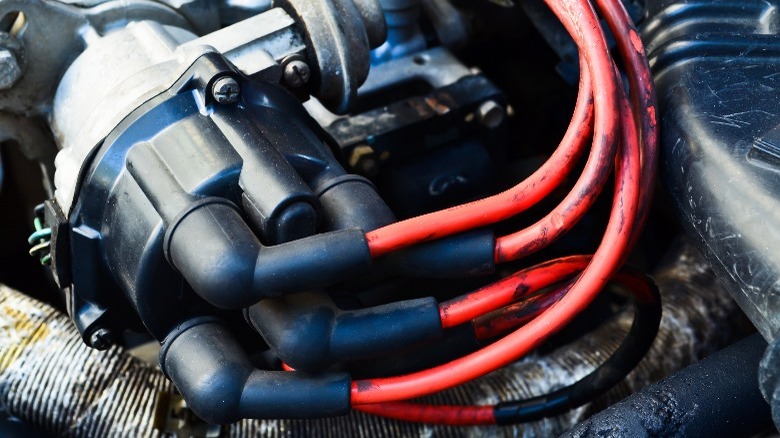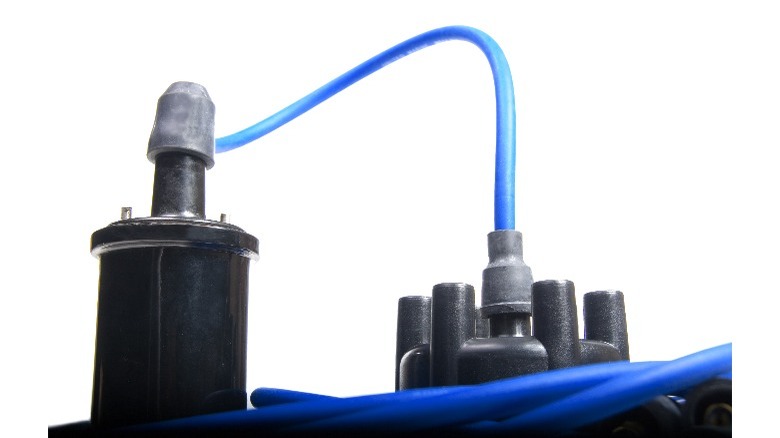7 Reasons You Might Need To Change The Distributor Cap On Your Vehicle
If you have a classic, vintage, or otherwise old car, you've probably heard of the distributor that it features. It's part of the ignition system that transfers current from the battery to the ignition coil and then to the spark plugs that fire in the engine cylinders, igniting the compressed fuel-air mixture. If any part of the distributor system gets spoiled, the car can exhibit problems in starting, accelerating, and even misfiring, among other issues. A distributor cap is one of two vital parts (the other being the rotor) found in distributors, an electrical-mechanical ignition system that was invented in the early 1900s and used in early automobiles.
Distributor tech remained largely unchanged all the way up to the 1970s when electronic ignition was introduced, and in the next decade, distributor-less (or direct) ignition systems were employed. By the mid-2000s, distributor ignition technology was almost completely done away with. Since then, most cars have featured electronic fuel injection and ignition systems that are controlled by a computerized ECU/ECM (engine control unit or module). If you have a car with a distributor-based ignition system, you will want to know the possible problems that can be caused if the system goes bad. In most cases, you will have to replace the distributor cap or rotor (or both).
How does a distributor work?
Before we get into the symptoms of a bad distributor, understanding how the distributor works will be helpful in understanding attendant problems. In older cars, the distributor serves the function of distributing the high-voltage electricity from the ignition coil (which, at engine start, receives low-voltage current from the battery) to the spark plugs in the engine's cylinders. To achieve this, a distributor unit is made up of a distributor cap with a line carrying the voltage from the ignition coil, connected to a rotor inside that rotates at a set speed to pass the voltage sequentially to each cylinder's contact point, with lines going to the respective cylinder's spark plug.
In such a design, there is always one more line on the distributor cap than the number of cylinders in the car, with the additional line being the one from the ignition coil, and the rest going to the individual spark plugs. The rotor is powered by current from the ignition coil, and its speed determines the ignition timing and engine firing. Timing is also based on two types of distributor advance – mechanical and vacuum advance. Problems in a distributor setup can be the result of wear and tear of the cap and rotor, as well as bad timing of the rotor. Do note that whenever any part of a distributor is replaced, the ignition timing, mechanical advance, and vacuum advance should also be adjusted to ensure the engine fires correctly.
Visible wear and tear of distributor cap
Wear and tear of the distributor cap can be seen as a broken spark plug wire tower, cracks or moisture on the cap, or burned out, corroded, or greasy terminals. If you notice such wear and tear on your distributor cap, you should immediately take your car to a mechanic to get the cap repaired or replaced because it's a vital part of your car's running. While visible wear and tear may not have resulted in issues, it points to imminent failures, perhaps in the middle of the highway, far from a mechanic.
Distributor caps don't often require maintenance, with the recommended replacement date roughly set at 50,000 miles or five years, whichever comes first — some people recommend every three years. However, since it is a part used continuously in a running car, from start to finish of any journey, it has its fair share of wear and tear. The fact that it deals with high voltage from the ignition coil also makes it susceptible to issues. Extremely cold weather is a common cause for distributor cap problems, as the cap may freeze in the cold, and starting the car results in a sudden burst of heat that can sometimes crack the cap.
Trouble starting the car
The distributor is directly responsible for starting the car since it routes power from the battery and ignition coil to the spark plugs of the engine cylinders. Thus, as you can imagine, if your distributor cap is bad, one of the symptoms you might face is trouble starting the car. It's also possible that the car cranks, but the engine does not turn over — which means the crankshaft isn't able to get the engine running. This could also be caused by issues with the distributor cap.
Of course, there are several other reasons your car could have trouble starting, including a weak battery, incorrect ignition timing, crankshaft issues, a malfunctioning timing belt, a dirty or cold carburetor, faulty coils, and even dirty or failing spark plugs. However, due to its vital role in starting the engine, it wouldn't hurt to check the state of your distributor cap while troubleshooting. Common causes of distributor-related starting issues include a cracked distributor cap, corrosion or dirt on the terminals or points, problems with the lines from the ignition coil or those going to the spark plugs, a broken spark plug wire tower, incorrect ignition timing, or a malfunctioning rotor.
Misfiring engine (knocking, shaking, rough idling, and lack of power)
Apart from starting the car, the distributor is also responsible for sending current to each spark plug in the engine cylinders while the car is running. A faulty distributor, whether the cap or the rotor, could cause problems during the car's motion, such as misfiring of the engine and improper ignition timing. This might result in a knocking noise, reduced acceleration and power, rough idling, or even a jarring shaking from the engine.
Similar to starting trouble, other reasons besides a bad distributor could cause your car engine to misfire, have rough idling, shake unexpectedly while running, or deliver reduced power. These include a dirty carburetor or spark plugs, cylinder and valve problems, corroded cables, and more. However, the distributor should be part of your checklist when you troubleshoot. Often, a cracked distributor cap is enough to cause such issues.
Check Engine light turns on
The Check Engine light may turn on when a distributor goes bad. This could be because of improper combustion or incorrect distribution of voltage, which can be caused by a cracked or corroded distributor cap or issues with the distributor's rotor. So, if you see the Check Engine light come on and your car faces any other symptoms described in this article, you likely have a faulty distributor.
Of course, there may be plenty of other reasons why the Check Engine light comes on, including spark plugs, malfunctioning engine sensors, low oil pressure, transmission issues, a loose gas cap, a faulty (or missing) catalytic converter, an overheating engine, impure gasoline, or some other engine problem. If your Check Engine light comes on, especially if it starts flashing, it's advised to stop the car and call a mobile mechanic or tow truck, or if that's not possible, it's important to drive slowly and visit the nearest service station.
Squealing or sputtering noises from the engine
Another sign that you may need to change (or at least clean) your distributor cap is if you hear high-pitched squealing or whistling noises from your engine. This may be due to the distributor cap being dirty or greasy, causing the air that circulates in the engine to squeal against a clogged distributor cap and its dirty bearings. You may also hear sputtering, tapping, or clicking noises, which can again point to a bad distributor not firing up the cylinders correctly.
While there are other issues with the engine that can cause these sounds, such as a bad fan belt or a bad tank of gas (sometimes fixed by a fuel stabilizer), it is important to keep the distributor as part of your checklist when troubleshooting. If other symptoms on this list accompany the noise, it becomes more likely that the distributor is the cause.
Stalling engine or backfiring exhaust
If your car is stalling, it is possible your distributor cap is to blame. If it is broken or dirty enough to cause a blockage, the distributor's rotor will be unable to rotate properly to deliver voltage to the cylinders. If the rotor's motion is impeded, it may cause the car to stall while running. Another similar issue is backfiring , where, due to the incorrect rotation of the rotor or possible dirt or moisture in the distributor cap, electricity from the ignition coil is routed to the wrong cylinder during the combustion cycle.
As with most distributor cap symptoms, other issues may be causing the car to stall or backfire. However, it is wise to keep the distributor in mind when troubleshooting. Apart from the distributor, the problem could be caused by dirt accumulation on the various points, spark plugs, and lines connected to it.
Excessive fuel consumption
Keeping all the other symptoms in mind, it's easy to see that a faulty distributor could lead to reduced mileage or increased fuel consumption due to engine misfiring, improper ignition timing, and car starting issues. This is because a defective distributor cap or rotor will reduce the efficiency of the combustion process in the engine, leading to more fuel being burned than what the engine requires to run.
As with the previous car problems discussed, reduced mileage could be caused by other car or engine issues. However, if you are facing additional distributor symptoms, the distributor is likely the culprit. Remember to periodically check the health of your distributor by visually inspecting it for signs of wear and tear. Minor adjustments, such as cleaning the cap and terminals, changing the lines, and tweaking the ignition timing, could fix the issues before you invest in a distributor replacement.
